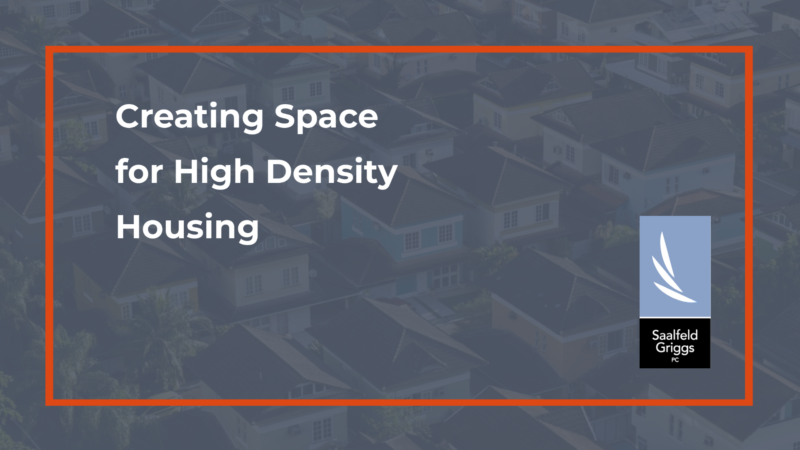By Margaret Gander-Vo, Associate in Real Estate and Land Use practice group
What is House Bill 2001?
The most recent estimates from Up for Growth, a national coalition that promotes higher-density housing near commercial centers, indicates that Oregon needs approximately 150,000 additional homes to meet current housing needs. This number has steadily increased over the last decade as the construction of new housing units has lagged population growth coming out of the Great Recession. In response to Oregon’s worsening housing crisis, the State Legislature passed HB 2001 in 2019 with a focus on increasing the supply of “middle housing.” Under the bill, “Middle Housing” is defined as duplexes, triplexes, quadplexes, cottage clusters, and townhouses. Practically, this will allow the expansion or replacement of single-family houses with higher density housing without requiring developers to file for a conditional use permit or zone change in areas zoned for single-family use. The Land Conservation and Development Department (DLCD) recently completed rulemaking to implement HB 2001 as it applies to “Medium Cities,” releasing administrative rules that will take effect on January 1, 2021. DLCD issued Model Rules in early April.
The goal of the legislation is to encourage a diversity of housing options throughout existing residential areas, allowing for higher density in areas previously reserved for single-family housing by requiring cities with a population of 25,000 or greater (includes Salem and Keizer in the Willamette Valley with Woodburn likely to follow upon 2020 census being finalized) to allow all types of middle housing in any residential zone that allows for single-family housing. For Medium Cities, with populations between 10,000 and 25,000 (cities around the size of Dallas and Newberg with Silverton likely to join following 2020 census), the development of duplexes will be permitted outright in any zone that allows single-family housing.
Proponents believe this will increase density and housing supply, decrease the cost of housing, and promote equity and diversity within communities. Zoning laws shape the type of neighborhoods developed and impact which people live in them. Proponents of HB 2001 see the diversity of housing types as a tool to improve access to various neighborhoods eliminating government barriers. The efficacy of these attempts is limited in part by the exemption of preexisting CC&Rs, which are not barred by HB 2001. DLCD attempted to address some of these concerns in the newly adopted rules, but the effectiveness of these mechanisms will remain largely dependent on local implementation.
Opponents are concerned that HB 2001 takes discretion away from local governments’ ability to make choices regarding what is appropriate for their community. They fear that eliminating single-family housing zones will lead to increases in housing costs, unsustainable burdens on infrastructure, and loss of historic homes. Specifically, detractors point out that HB 2001 does not require local governments to consider whether changes to their comprehensive plans allowing for more middle housing in traditionally single-family residential zones will have an impact of existing or planned transportation facilities.
How will this look in Oregon?
The practical effects of HB 2001 will manifest differently in different locations. For example, in Salem duplexes and townhouses are permitted under limited circumstances within the Single Family Residential (RS) zone and another multifamily is prohibited. In this instance, the likely result is that existing dual living situations will be utilized with greater regularity without significant impact to neighboring properties while the larger permitted multi-family usage will continue to be infrequently used in traditional single-family neighborhoods due to the high cost of infrastructure improvements that would be triggered by large multifamily developments in these areas.
HB 2001 may increase the use of cottage clusters in cities. A cottage cluster is a grouping of at least four detached houses with a footprint of less than 900 square feet looking onto a common courtyard. Cottage clusters have been gaining in popularity over recent years to increase density while promoting community in urban centers. There are examples of cottage clusters in Oregon such as Cully Grove in Portland and NW Crossing in Bend. Salem approved a modified version at Pringle Creek. However, there is little evidence to suggest that this product provides affordable housing or even a higher density of housing than other forms of multifamily housing. The homes in NW Crossing cost the same amount as a traditional single-family home of the same size. What is apparent is that this housing offers a different type of community-focused around building relationships, facilitating a discussion on what form and function neighborhoods should take during a period when traditional homeownership is out of reach for many and intergenerational living units are on the rise.
HB 2001 requires more a diversity of housing types than is currently allowed in cities in the Willamette Valley. However, this likely will not cause widespread infill as the development of higher density housing typically leads to higher development costs than the small lot single-family housing developments that have become the norm over the past few years.
Margaret Gander-Vo is an associate in the Real Estate and Land Use practice group. The information in this article is not intended to provide legal advice. For professional
consultation, please contact Margaret at margaret@sglaw.com at Saalfeld Griggs PC. 503.399.1070. © 2020 Saalfeld Griggs PC

